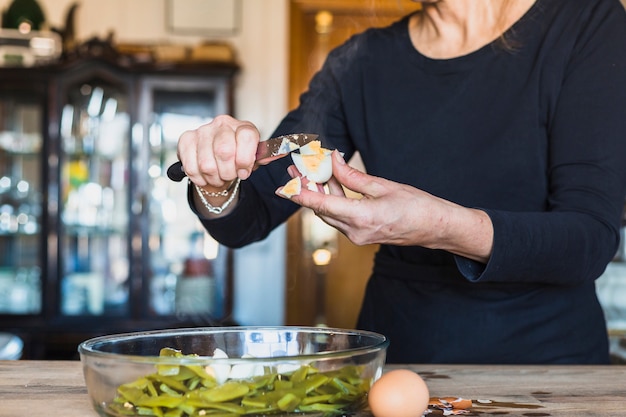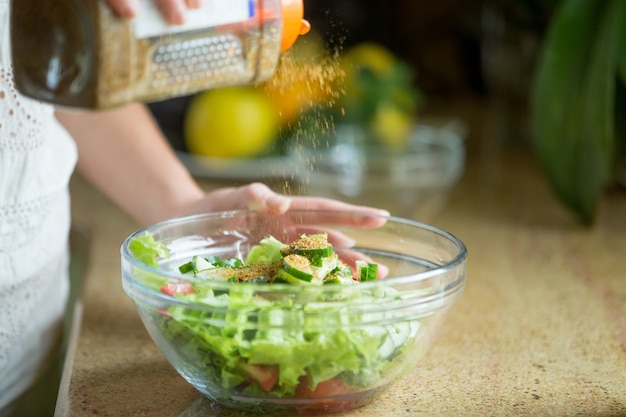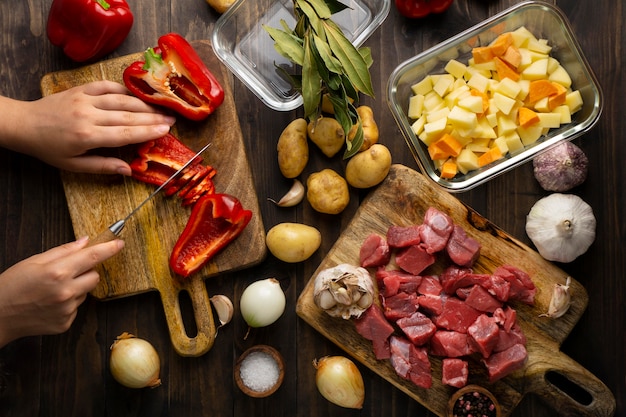Right, so you want to make the perfect Caesar salad, eh? Well, buckle up, because we're about to embark on a culinary journey that's going to transform your salad game. I've spent years perfecting this recipe, trying countless variations and experimenting with different ingredients. Let me tell you, the key to a truly amazing Caesar isn't just about tossing some lettuce with dressing, it's about a symphony of flavors and textures that dance on your palate.
We're going to dive deep into the secrets of this classic dish, from the perfect anchovy-infused dressing to the crispy croutons that add that satisfying crunch. I'll also share my personal tips and tricks that have made my Caesar salad the envy of friends and family. Get ready to impress with this masterpiece! So, let's get started, shall we?
(Part 1) The Foundation: Choosing the Right Ingredients

Just like a good foundation is crucial to building a sturdy house, the right ingredients are essential for a spectacular Caesar salad. You can't just grab any old lettuce and expect it to sing. No, my friend, we need the real deal.
The Lettuce: Roman, Romaine, and Nothing Else
Let's be honest, the star of the show is the lettuce. And in the world of Caesar salads, there's only one true king: romaine lettuce. Its crisp, sturdy leaves are the perfect canvas for the dressing, croutons, and Parmesan.
Now, I know you might be tempted to use other types of lettuce, but trust me on this one. Romaine has a unique quality. It's crisp and sturdy enough to hold up under the weight of the dressing, ensuring every bite is a delight. And those firm leaves have a slightly bitter bite that contrasts beautifully with the creamy dressing and salty Parmesan. You won't find that combination with any other lettuce.
The Dressing: A Symphony of Flavours
The dressing is the heart and soul of a Caesar salad. It's a delicate balance of salty, tangy, and creamy, and it's absolutely essential to get it right.
I'm talking about an anchovy-infused dressing, my friends. Don't be afraid of the anchovies. They add a subtle umami depth that elevates the entire dish.
Now, there are two ways to go about making your dressing:
- The Traditional Route: This is all about creating a homemade emulsified dressing from scratch. You'll start with a base of lemon juice, Dijon mustard, and garlic, then whisk in olive oil slowly until you achieve that creamy, dreamy consistency.
- The Shortcut: Let's be real, sometimes we just don't have the time (or energy) to get fancy. In those cases, I recommend using a good quality bottled Caesar dressing. Just make sure it's made with real anchovies and doesn't contain any weird artificial ingredients.
Whichever route you choose, remember that the dressing is the key to a truly authentic Caesar salad. It's what brings all the flavors together and gives the salad its unique character.
The Parmesan: The King of Cheeses
Parmesan, my dear friends, is not just some cheese. It's the king of all cheeses. I know you might be tempted to use a cheaper substitute, but please, don't. It’s worth investing in a good quality block of Parmigiano-Reggiano for that sharp, nutty flavour that elevates the entire salad.
Parmesan adds a salty, umami richness that complements the anchovies in the dressing perfectly. It also provides a textural contrast, with its sharp, crystalline flakes adding a satisfying crunch to the creamy dressing and soft lettuce.
The Croutons: The Crunch Factor
You want your croutons to have that perfect crunch – not too hard, not too soft, just the right amount of texture to contrast with the soft lettuce. I've found that using stale bread, preferably a baguette, works best for the perfect crouton.
Stale bread absorbs the olive oil and garlic better, resulting in a more flavourful and crispy crouton. It also prevents the croutons from becoming soggy when tossed with the dressing.
The Other Essential Ingredients
Of course, a Caesar salad wouldn't be complete without a few other essential ingredients:
- Black Pepper: Freshly ground black pepper adds a spicy kick to the dressing. A good quality pepper mill is worth the investment for this.
- Salt: Salt, my friend, is the seasoning that makes all the flavours pop. Use it liberally, but be mindful of the saltiness from the anchovies and Parmesan.
- Olive Oil: A good quality extra virgin olive oil is a must for the dressing. It brings a fruity, peppery flavour that complements the other ingredients beautifully.
(Part 2) The Art of Dressing: A Symphony of Flavors

Now that you have all the ingredients, it's time to create the magic. Making the perfect Caesar dressing is all about technique and a bit of intuition.
The Traditional Method: A Labor of Love
For those who like to get their hands dirty and appreciate the satisfaction of making everything from scratch, here's the traditional method:
- Prep the Ingredients: Start by finely chopping two cloves of garlic. Then, add a tablespoon of Dijon mustard, a tablespoon of lemon juice, and a pinch of salt to a small bowl. Use a fork to whisk it all together until it’s smooth and creamy. You want a nice, emulsified base for your dressing.
- Incorporate the Anchovies: Now comes the secret ingredient: anchovies. You'll need about four fillets, which you can chop finely or mash into a paste with a fork. Add the anchovies to the bowl and whisk until fully incorporated. This is where the real flavor magic starts to happen.
- Emulsify the Dressing: This is where the magic happens. You'll need to whisk in the olive oil, little by little, while continuously whisking. The key is to create a smooth and creamy emulsion. You'll know you’ve done it right when the dressing becomes thick and glossy. This process takes a bit of time and patience, but the results are worth it.
- Season to Taste: Finally, taste the dressing and adjust the seasoning to your liking. Add more lemon juice for extra tartness, more salt for saltiness, or a bit more Dijon mustard for a spicier kick.
Remember, a little goes a long way with anchovies. Start with a small amount and adjust to your taste. You want a subtle, umami flavour, not a strong fishy taste.
The Shortcut: A Time-Saving Option
Sometimes, we just don't have the time (or energy) for the traditional method. For those times, a good quality bottled Caesar dressing can be a real lifesaver. Just make sure you choose a dressing made with real anchovies and no artificial ingredients.
I personally prefer the taste of a homemade dressing, but I'm not going to judge you if you opt for a shortcut. After all, the most important thing is that you enjoy your salad.
(Part 3) The Croutons: A Crunch of Perfection

Now, let's talk about those croutons, the little guys that add that satisfying crunch to every bite. Making homemade croutons is incredibly easy, and it really elevates the entire salad.
The Perfect Crouton: A Step-by-Step Guide
Here's my foolproof method for making the perfect croutons:
- Choose the Right Bread: I recommend using a day-old baguette. The stale bread will absorb the olive oil and garlic better, resulting in a more flavourful and crispy crouton. You can also use other types of bread, like sourdough or country loaf, but a baguette is my personal favourite.
- Dice the Bread: Cut the baguette into cubes, about half an inch in size. Make sure the cubes are evenly sized so they bake evenly.
- Toss with Olive Oil and Garlic: In a bowl, toss the bread cubes with a couple of tablespoons of olive oil and a clove of minced garlic. You can also add a pinch of salt and pepper for extra flavour. Make sure the bread is well coated with the oil and garlic mixture.
- Bake to Perfection: Spread the bread cubes on a baking sheet and bake in a preheated oven at 350°F (175°C) for about 10-15 minutes, or until golden brown and crispy. Make sure to flip the croutons halfway through baking for even browning.
The key is to bake the croutons until they're golden brown and crispy but not burnt. You want that perfect crunch that adds texture and flavour to your salad. And don't forget to let the croutons cool completely before adding them to the salad, otherwise, they'll soften the lettuce.
(Part 4) The Lettuce: The Perfect Base
Now, let's get to the heart of the matter: the lettuce. You want to make sure you choose the freshest romaine lettuce possible, with crisp, firm leaves.
Washing and Drying: A Crucial Step
Before you start assembling your salad, it's important to wash and dry the lettuce properly.
- Wash Thoroughly: Rinse the romaine lettuce under cold running water to remove any dirt or debris. Make sure to separate the leaves and wash them individually.
- Dry Completely: Once the lettuce is washed, it's important to dry it completely. You can use a salad spinner or pat the leaves dry with paper towels. If you don't dry the lettuce properly, the dressing will become watery and the salad will be soggy.
Don't skip this step! A well-washed and dried lettuce will make all the difference in the texture and freshness of your salad.
Chopping the Lettuce: The Right Technique
You want to chop the lettuce into bite-sized pieces that will be easy to toss with the dressing.
- The Chop: I like to use a sharp chef's knife to chop the lettuce into strips about 1/2 inch wide. This ensures that the lettuce is evenly chopped and easy to eat.
(Part 5) Assembling the Masterpiece: The Art of Layering
Now that you have all your components – the perfect dressing, crispy croutons, and crisp, fresh lettuce – it's time to assemble the salad. This is where the art of layering comes into play.
The Foundation: The Lettuce
Start with the lettuce, creating a base for your salad. You can either chop the lettuce into bite-sized pieces and toss them in a bowl, or arrange the leaves on a platter. The tossing method is more traditional and ensures that all the ingredients are well combined. The plating method is more visually appealing, and it allows you to create a more dramatic presentation.
The Crunch: The Croutons
Next, add the croutons. You want to sprinkle them evenly over the lettuce, ensuring that every bite has that satisfying crunch. Don't be afraid to add a generous amount of croutons, they are a key part of the texture and flavor of the salad.
The Flavour: The Dressing
Now comes the dressing. I like to drizzle the dressing over the salad, making sure to coat every leaf evenly. You can also toss the salad with the dressing, but I find that drizzling it on top helps preserve the crispness of the lettuce.
For a more traditional presentation, drizzle the dressing over the salad just before serving. This ensures that the lettuce stays crisp and the dressing doesn't make the salad soggy.
The Top Layer: The Parmesan
Finally, sprinkle the Parmesan cheese over the top. I use a cheese grater to create thin shavings of Parmesan, which add a beautiful visual element to the salad.
If you want to get fancy, you can use a vegetable peeler to create long, thin ribbons of Parmesan. This adds a touch of elegance to the salad and makes it more visually appealing.
Remember, when assembling your Caesar salad, it's all about balance. You want a good ratio of lettuce, dressing, and croutons. Don't be afraid to adjust the ingredients based on your personal preferences.
(Part 6) The Final Touches: Adding a Personal Flair
You've got the foundation, the dressing, the croutons, and the lettuce. Now, let's add those finishing touches that will make your Caesar salad truly sing.
The Garnish: A Touch of Elegance
A garnish is a simple way to add a touch of elegance to your Caesar salad. You can use anything from cherry tomatoes to fresh basil leaves, but my favourite garnish is a sprinkle of black pepper.
I like to use a pepper mill and freshly ground black pepper for that extra burst of flavour. Just a little sprinkle over the top will elevate the salad to new heights.
The Presentation: A Visual Delight
Presentation is key when it comes to food. You want to create a visually appealing salad that will entice your guests. I like to serve my Caesar salad on a large platter, with the lettuce arranged neatly in the center. I then scatter the croutons and sprinkle the Parmesan cheese around the edges, creating a visually appealing presentation.
To make your presentation even more eye-catching, you can use a variety of different bowls and platters. For example, you could use a large wooden bowl for a rustic look, or a white ceramic platter for a more modern aesthetic. You can also use a variety of serving utensils, such as tongs or a salad spoon, to make your presentation more elegant.
(Part 7) Serving and Enjoying: A Culinary Celebration
You've gone through all the effort, now it's time to enjoy your creation. Here are a few tips for serving and enjoying your Caesar salad:
Serving Temperature: Chilling for Optimal Flavour
I prefer to serve my Caesar salad chilled. It’s just more refreshing that way. You can chill the salad in the refrigerator for about 30 minutes before serving.
This will help to keep the lettuce crisp and the dressing cold and creamy. If you are serving the salad to guests, it is a good idea to chill the salad plates as well. This will help to keep the salad cold and prevent the dressing from melting too quickly.
The Best Accompaniments: Pairings That Elevate the Flavours
A Caesar salad is perfect on its own, but it can also be paired with other dishes to create a complete meal.
- grilled chicken or Steak: Add a protein like grilled chicken or steak for a hearty and satisfying meal. The grilled chicken or steak will provide a nice contrast in texture and flavour to the salad.
- Roasted Vegetables: For a lighter option, pair your salad with roasted vegetables like asparagus, broccoli, or Brussels sprouts. Roasted vegetables will add a touch of sweetness and earthiness to the salad, and they are a great source of vitamins and minerals.
- Crustless Quiche: A crustless quiche is a great way to add a touch of elegance to your meal. It is also a lighter option than grilled chicken or steak, and it can be made ahead of time.
(Part 8) FAQs: Answering Your Burning Questions
So, you've conquered the Caesar salad, but still have some burning questions? Here are some common FAQs that will clear up any doubts you might have:
1. Can I Use Bottled Lemon Juice Instead of Fresh?
You can, but it won’t taste as good as fresh lemon juice. The acidity of fresh lemon juice is more intense and adds a brighter, more vibrant flavour to the dressing.
If you are using bottled lemon juice, make sure to use a good quality brand. You may also want to add a bit more lemon juice than you would if you were using fresh lemon juice.
2. How Long Can I Store Leftover Caesar Salad?
It’s best to enjoy your Caesar salad fresh. However, if you have leftovers, you can store them in an airtight container in the refrigerator for up to 2 days. Just be aware that the lettuce will start to wilt a bit over time.
If you are storing leftover Caesar salad, it is best to store the lettuce and dressing separately. This will help to prevent the lettuce from becoming soggy. You can also add a few drops of lemon juice to the dressing to help preserve its freshness.
3. Can I Substitute Another Type of Cheese for the Parmesan?
While Parmesan cheese is the traditional cheese for a Caesar salad, you can use other types of hard cheeses as substitutes. Pecorino Romano is a good option, or you could try a sharp cheddar or Asiago. But I recommend sticking with Parmesan for the classic flavour profile.
If you are using a substitute cheese, be sure to taste the salad and adjust the seasoning accordingly. You may need to add more salt or pepper to compensate for the different flavour of the cheese.
4. Should I Use Whole Anchovies or Anchovy Paste?
Both whole anchovies and anchovy paste will work. If using whole anchovies, chop them finely or mash them into a paste with a fork. Anchovy paste is already a paste, so you can just add it directly to the dressing.
The key is to use a high-quality anchovy product, whether you choose whole anchovies or anchovy paste. You want a flavour that is subtle and umami, not strong and fishy.
5. Why Does My Caesar Salad Dressing Separate?
If your Caesar salad dressing separates, it's usually because the emulsion hasn't been properly formed. Make sure to whisk in the olive oil slowly, while continuously whisking, to create a smooth and creamy emulsion. You can also try adding a small amount of Dijon mustard or lemon juice to help stabilize the dressing.
If the dressing still separates, you can try gently warming it over low heat. This will help to melt the cheese and create a smoother emulsion. However, be careful not to overheat the dressing, as this can cause it to curdle.
Now that you've read through this ultimate guide to making the perfect Caesar salad, it's time to put your skills to the test. Go forth, my friend, and create a culinary masterpiece that will impress even the most discerning palate.
Everyone is watching

Perfect Rice Every Time: The Ultimate Guide to Cooking Rice
Cooking TipsAs a self-proclaimed foodie, I've always been a bit obsessed with rice. It's the foundation of countless cuisi...

The Ultimate Guide to Cooking Asparagus: Tips, Techniques, and Recipes
Cooking TipsAsparagus. The mere mention of this spring delicacy conjures up images of vibrant green spears, crisp and burs...

Ultimate Guide to Cooking the Perfect Thanksgiving Turkey
Cooking TipsThanksgiving. Just the word conjures up images of overflowing tables laden with delicious food, the scent of r...

Can You Cook Spaghetti with Gasoline? (The Shocking Truth)
Cooking TipsWe've all seen those crazy internet trends. You know, the ones that make you wonder, "Did someone actually try...

Chorizo and Eggs Recipe: The Ultimate Guide
Cooking TipsRight, let’s talk about chorizo and eggs. You know, that classic Spanish dish that's always a winner. It's th...
